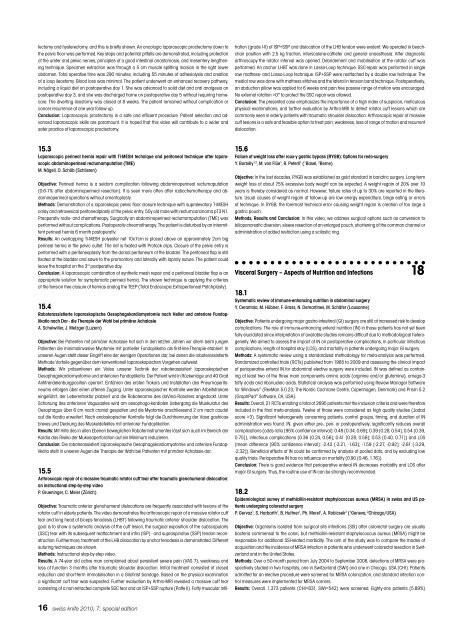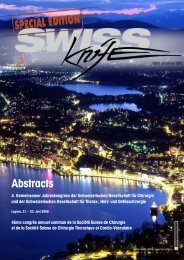Anorectal Manometry in 3D NEW! - Swiss-knife.org
Anorectal Manometry in 3D NEW! - Swiss-knife.org
Anorectal Manometry in 3D NEW! - Swiss-knife.org
You also want an ePaper? Increase the reach of your titles
YUMPU automatically turns print PDFs into web optimized ePapers that Google loves.
tectomy and hysterectomy, and this is briefly shown. An oncologic laparoscopic proctectomy down to<br />
the pelvic floor was performed. Key steps and potential pitfalls are demonstrated, <strong>in</strong>clud<strong>in</strong>g protection<br />
of the ureter and pelvic nerves, pr<strong>in</strong>ciples of a good <strong>in</strong>test<strong>in</strong>al anastomosis, and mesentery lengthen<strong>in</strong>g<br />
technique. Specimen extraction was through a 5 cm muscle splitt<strong>in</strong>g <strong>in</strong>cision <strong>in</strong> the right lower<br />
abdomen. Total operative time was 290 m<strong>in</strong>utes, <strong>in</strong>clud<strong>in</strong>g 55 m<strong>in</strong>utes of adhesiolysis and creation<br />
of a loop ileostomy. Blood loss was m<strong>in</strong>imal. The patient underwent an enhanced recovery pathway,<br />
<strong>in</strong>clud<strong>in</strong>g a liquid diet on postoperative day 1. She was advanced to solid diet and oral analgesia on<br />
postoperative day 3, and she was discharged home on postoperative day 5 without requir<strong>in</strong>g homecare.<br />
The divert<strong>in</strong>g ileostomy was closed at 8 weeks. The patient rema<strong>in</strong>ed without complication or<br />
cancer recurrence at one year follow-up.<br />
Conclusion: Laparoscopic proctectomy is a safe and efficient procedure. Patient selection and advanced<br />
laparoscopic skills are paramount. It is hoped that this video will contribute to a wider and<br />
safer practice of laparoscopic proctectomy.<br />
15.3<br />
Laparoscopic per<strong>in</strong>eal hernia repair with Ti-MESH technique and peritoneal technique after laparoscopic<br />
abdom<strong>in</strong>oper<strong>in</strong>eal rectumamputation (TME)<br />
M. Nägeli, O. Schöb (Schlieren)<br />
Objective: Per<strong>in</strong>eal hernia is a seldom complication follow<strong>in</strong>g abdom<strong>in</strong>oper<strong>in</strong>eal rectumaputation<br />
(0.6-7% after abdom<strong>in</strong>oper<strong>in</strong>eal resection). It is seen more often after radiochemotherapy and abdom<strong>in</strong>oper<strong>in</strong>eal<br />
operations without omentoplasty.<br />
Methods: Demonstration of a laparoskopic pelvic floor closure technique with supralevatory T-iMESH<br />
onlay and retrovesical peritonealplasty of the pelvic entry. 50y old male with rectumcarc<strong>in</strong>oma pT3 N1.<br />
Preoperativ radio- and chemotherapy. Surgically an abdom<strong>in</strong>oper<strong>in</strong>eal rectumamputation (TME) was<br />
performed without complications. Postoperativ cheomotherapy. The patient is disturbed by an <strong>in</strong>termittent<br />
per<strong>in</strong>eal hernia 6 month postoperativ.<br />
Results: An overlapp<strong>in</strong>g Ti-MESH polyester net 10x7cm is placed above an approximately 2cm big<br />
per<strong>in</strong>eal hernia <strong>in</strong> the pelvic outlet. The net is fixated with Protack clips. Closure of the pelvic entry is<br />
performed with a peritoneoplasty from the dorsal peritoneum of the bladder. The peritoneal flap is still<br />
fixated at the bladder and sawn to the promontory and laterally with lapraty suture. The patient could<br />
leave the hospital on the 3 rd postperative day.<br />
Conclusion: A laparoscopic comb<strong>in</strong>ation of synthetic mesh repair and a peritoneal bladder flap is an<br />
appropriate solution for symptomatic per<strong>in</strong>eal hernia. The shown technique is apply<strong>in</strong>g the criterias<br />
of the tension free closure of hernias analog the TEEP (Total Endoscopic Extraperitoneal Patchplasty).<br />
15.4<br />
Roboterassistierte laparoskopische Oesophagokardiomyotomie nach Heller und anteriore Fundoplikatio<br />
nach Dor - die Therapie der Wahl bei primärer Achalasie<br />
A. Scheiwiller, J. Metzger (Luzern)<br />
Objective: Bei Patienten mit primärer Achalasie hat sich <strong>in</strong> den letzten Jahren vor allem beim jungen<br />
Patienten die m<strong>in</strong>imal<strong>in</strong>vasive Myotomie mit partieller Fundoplikatio als first-l<strong>in</strong>e-Therapie etabliert. In<br />
unseren Augen stellt dieser E<strong>in</strong>griff e<strong>in</strong>e der wenigen Operationen dar, bei denen die roboterassistierte<br />
Methode Vorteile gegenüber dem konventionell laparoskopischen V<strong>org</strong>ehen aufweist.<br />
Methods: Wir präsentieren e<strong>in</strong> Video unserer Technik der roboterassistiert laparoskopischen<br />
Oesophagokardiomyotomie und anterioren Fundoplikatio. Der Patient wird <strong>in</strong> Rückenlage und 40 Grad<br />
Antitrendelenburgposition operiert. E<strong>in</strong>führen des ersten Trokars und Installation des Pneumoperitoneums<br />
erfolgen über e<strong>in</strong>en offenen Zugang. Unter laparoskopischer Kontrolle werden Arbeitstrokare<br />
e<strong>in</strong>geführt, der Leberretraktor platziert und die Roboterarme des daV<strong>in</strong>ci-Roboters angedockt. Unter<br />
Schonung des anterioren Vagusastes wird am oesophago-kardialen Uebergang die Muskulatur des<br />
Oesophagus über 6 cm nach cranial gespalten und die Myotomie anschliessend 2 cm nach caudal<br />
auf die Kardia erweitert. Nach endoskopischer Kontrolle folgt die Durchtrennung der Vasa gastricae<br />
breves und Deckung des Muskeldefektes mit anteriorer Fundoplikation.<br />
Results: Mit Hilfe des <strong>in</strong> allen Ebenen beweglichen Roboter<strong>in</strong>strumentes lässt sich auch im Bereich der<br />
Kardia das Risiko der Mukosaperforation auf e<strong>in</strong> M<strong>in</strong>imum reduzieren.<br />
Conclusion: Die roboterassistiert laparoskopische Oesophagokardiomyotomie und anteriore Fundoplikatio<br />
stellt <strong>in</strong> unseren Augen die Therapie der Wahl bei Patienten mit primärer Achalasie dar.<br />
15.5<br />
Arthroscopic repair of a massive traumatic rotator cuff tear after traumatic glenohumeral dislocation:<br />
an <strong>in</strong>structional step-by-step video<br />
P. Gruen<strong>in</strong>ger, C. Meier (Zürich)<br />
Objective: Traumatic anterior glenohumeral dislocations are frequently associated with lesions of the<br />
rotator cuff <strong>in</strong> elderly patients. The video demonstrates the arthroscopic repair of a massive rotator cuff<br />
tear and long head of biceps tenodesis (LHBT) follow<strong>in</strong>g traumatic anterior shoulder dislocation. The<br />
goal is to show a systematic analysis of the cuff lesion, the surgical exposition of the subscapularis<br />
(SSC) tear with its subsequent reattachment and <strong>in</strong>fra (ISP) - and suprasp<strong>in</strong>atus (SSP) tendon reconstruction.<br />
Furthermore, treatment of the LHB dislocation by anchor tenodesis is demonstrated. Different<br />
sutur<strong>in</strong>g techniques are shown.<br />
Methods: Instructional step-by-step video.<br />
Results: A 74-year old active man compla<strong>in</strong>ed about persistent severe pa<strong>in</strong> (VAS 7), weakness and<br />
loss of function 3 months after traumatic shoulder dislocation. Initial treatment consisted of closed<br />
reduction and short-term immobilisation <strong>in</strong> a Gilchrist bandage. Based on the physical exam<strong>in</strong>ation<br />
a significant cuff tear was suspected. Further evaluation by Arthro-MRI revealed a massive cuff tear<br />
consist<strong>in</strong>g of a non-retracted complete SSC tear and an ISP+SSP rupture (Patte II). Fatty muscular <strong>in</strong>fil-<br />
16 swiss <strong>knife</strong> 2010; 7: special edition<br />
tration (grade I-II) of ISP+SSP and dislocation of the LHB tendon were evident. We operated <strong>in</strong> beachchair<br />
position with 2.5 kg traction, <strong>in</strong>terscalene-catheter and general anaesthesia. After diagnostic<br />
arthroscopy the rotator <strong>in</strong>terval was opened. Debridement and mobilisation of the rotator cuff was<br />
performed. An anchor LHBT was done <strong>in</strong> Lasso-Loop technique. SSC-repair was performed <strong>in</strong> s<strong>in</strong>gle<br />
row mattress- and Lasso-Loop technique. ISP+SSP were reattached by a double row technique: The<br />
medial row was done with mattress stitches and the lateral <strong>in</strong> tension band technique. Postoperatively,<br />
an abduction pillow was applied for 6 weeks and pa<strong>in</strong> free passive range of motion was encouraged.<br />
No external rotation >0° to protect the SSC repair was allowed.<br />
Conclusion: The presented case emphasizes the importance of a high <strong>in</strong>dex of suspicion, meticulous<br />
physical exam<strong>in</strong>ations, and further evaluation by Arthro-MRI to detect rotator cuff lesions which are<br />
commonly seen <strong>in</strong> elderly patients with traumatic shoulder dislocation. Arthroscopic repair of massive<br />
cuff lesions is a safe and feasible option to treat pa<strong>in</strong>, weakness, loss of range of motion and recurrent<br />
dislocation.<br />
15.6<br />
Failure of weight loss after roux-y gastric bypass (RYGB): 0ptions for redo-surgery<br />
Y. Borbély 1,2 , M. von Flüe 1 , R. Peterli 1 ( 1 Basel, 2 Berne)<br />
Objective: In the last decades, RYGB was established as gold standard <strong>in</strong> bariatric surgery. Long-term<br />
weight loss of about 75% excessive body weight can be expected. A weight rega<strong>in</strong> of 20% over 10<br />
years is thereby considered as normal. However, failure rates of up to 30% are reported <strong>in</strong> the literature.<br />
Usual causes of weight rega<strong>in</strong> at follow-up are low energy expenditure, b<strong>in</strong>ge eat<strong>in</strong>g or errors<br />
of technique. In RYGB, the foremost technical error caus<strong>in</strong>g weight rega<strong>in</strong> is creation of too large a<br />
gastric pouch.<br />
Methods, Results and Conclusion: In this video, we address surgical options such as conversion to<br />
biliopancreatic diversion, sleeve resection of an enlarged pouch, shorten<strong>in</strong>g of the common channel or<br />
adm<strong>in</strong>istration of added restriction us<strong>in</strong>g a scilastic r<strong>in</strong>g.<br />
Visceral Surgery – Aspects of Nutrition and Infections 18<br />
18.1<br />
Systematic review of immune-enhanc<strong>in</strong>g nutrition <strong>in</strong> abdom<strong>in</strong>al surgery<br />
Y. Cerantola, M. Hübner, F. Grass, N. Demart<strong>in</strong>es, M. Schäfer (Lausanne)<br />
Objective: Patients undergo<strong>in</strong>g major gastro-<strong>in</strong>test<strong>in</strong>al (GI) surgery are still at <strong>in</strong>creased risk to develop<br />
complications. The role of immune-enhanc<strong>in</strong>g enteral nutrition (IN) <strong>in</strong> those patients has not yet been<br />
fully elucidated s<strong>in</strong>ce <strong>in</strong>terpretation of available studies rema<strong>in</strong>s difficult due to methodological heterogeneity.<br />
We aimed to assess the impact of IN on postoperative complications, <strong>in</strong> particular <strong>in</strong>fectious<br />
complications, length of hospital stay (LOS), and mortality <strong>in</strong> patients undergo<strong>in</strong>g major GI surgery.<br />
Methods: A systematic review us<strong>in</strong>g a standardized methodology for meta-analysis was performed.<br />
Randomized controlled trials (RCTs) published from 1985 to 2009 and assess<strong>in</strong>g the cl<strong>in</strong>ical impact<br />
of perioperative enteral IN for abdom<strong>in</strong>al elective surgery were <strong>in</strong>cluded. IN was def<strong>in</strong>ed as conta<strong>in</strong><strong>in</strong>g<br />
at least two of the three ma<strong>in</strong> components am<strong>in</strong>o acids (arg<strong>in</strong><strong>in</strong>e and/or glutam<strong>in</strong>e), omega-3<br />
fatty acids and ribonucleic acids. Statistical analysis was performed us<strong>in</strong>g Review Manager Software<br />
for W<strong>in</strong>dows ® (RevMan 5.0.23; The Nordic Cochrane Centre, Copenhagen, Denmark) and Prism 5.2<br />
(GraphPad ® Software, CA, USA).<br />
Results: Overall, 21 RCTs enroll<strong>in</strong>g a total of 2695 patients met the <strong>in</strong>clusion criteria and were therefore<br />
<strong>in</strong>cluded <strong>in</strong> the f<strong>in</strong>al meta-analysis. Twelve of those were considered as high quality studies (Jadad<br />
score >3). Significant heterogeneity concern<strong>in</strong>g patients, control groups, tim<strong>in</strong>g, and duration of IN<br />
adm<strong>in</strong>istration was found. IN, given either pre-, peri- or postoperatively, significantly reduces overall<br />
complications (odds ratio [95% confidence <strong>in</strong>terval]: 0.48 [0.34, 0.69]; 0.39 [0.28, 0.54]; 0.54 [0.39,<br />
0.75]), <strong>in</strong>fectious complications (0.36 [0.24, 0.56]; 0.41 [0.28, 0.58]; 0.53 [0.40, 0.71]) and LOS<br />
(mean difference [95% confidence <strong>in</strong>terval]: -2.42 [-3.21, -1.63]; -1.59 [-2.27, -0.92]; -2.81 [-3.29,<br />
-2.32]). Beneficial effects of IN could be confirmed by analysis of pooled data, and by exclud<strong>in</strong>g low<br />
quality trials. Perioperative IN has no <strong>in</strong>fluence on mortality (0.90 [0.46, 1.76]).<br />
Conclusion: There is good evidence that perioperative enteral IN decreases morbidity and LOS after<br />
major GI surgery. Thus, the rout<strong>in</strong>e use of IN can be strongly recommended.<br />
18.2<br />
Epidemiological survey of methicill<strong>in</strong>-resistant staphylococcus aureus (MRSA) <strong>in</strong> swiss and US patients<br />
undergo<strong>in</strong>g colorectal surgery<br />
P. Gervaz 1 , S. Harbarth 1 , B. Huttner 1 , Ph. Morel 1 , A. Robicsek 2 ( 1 Geneva, 2 Chicago/USA)<br />
Objective: Organisms isolated from surgical site <strong>in</strong>fections (SSI) after colorectal surgery are usually<br />
bacteria commensal to the colon, but methicill<strong>in</strong>-resistant staphylococcus aureus (MRSA) might be<br />
responsible for additional SSI-related morbidity. The aim of the study was to compare the modes of<br />
acquisition and the <strong>in</strong>cidence of MRSA <strong>in</strong>fection <strong>in</strong> patients who underwent colorectal resection <strong>in</strong> Switzerland<br />
and <strong>in</strong> the United States.<br />
Methods: Over a 50-month period from July 2004 to September 2008, detections of MRSA were prospectively<br />
studied <strong>in</strong> two hospitals, one <strong>in</strong> Switzerland (SWI) and one <strong>in</strong> Chicago, USA (CHI). Patients<br />
admitted for an elective procedure were screened for MRSA colonization, and standard <strong>in</strong>fection control<br />
measures were implemented for MRSA carriers.<br />
Results: Overall, 1,373 patients (CHI=831, SWI=542) were screened. Eighty-one patients (5.89%)
















